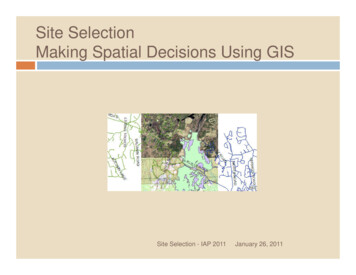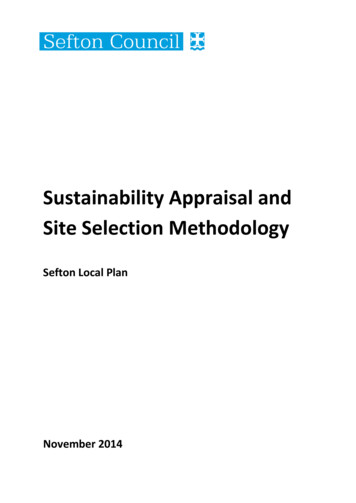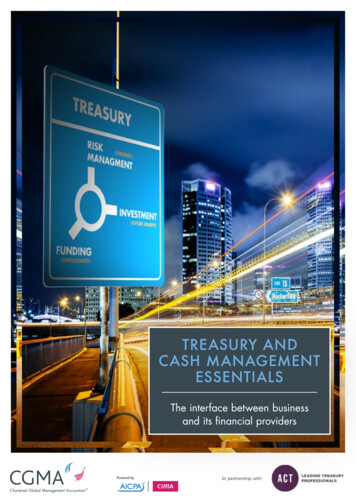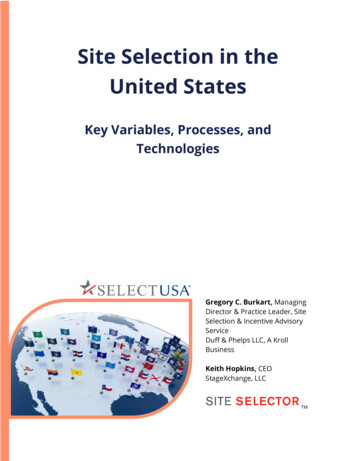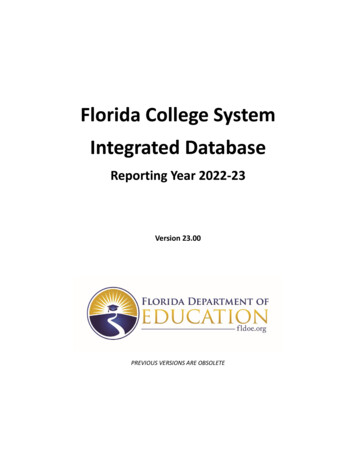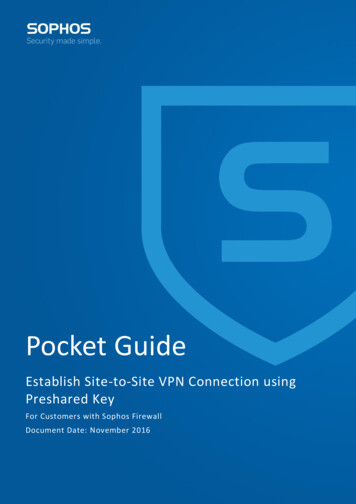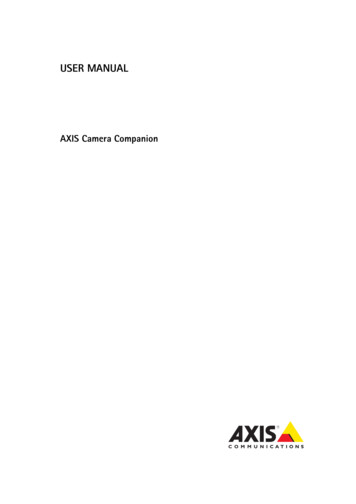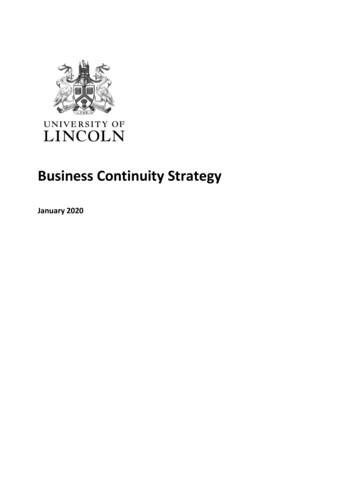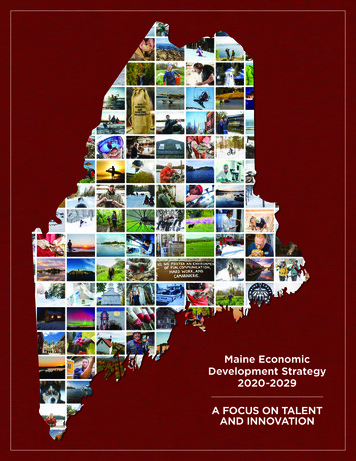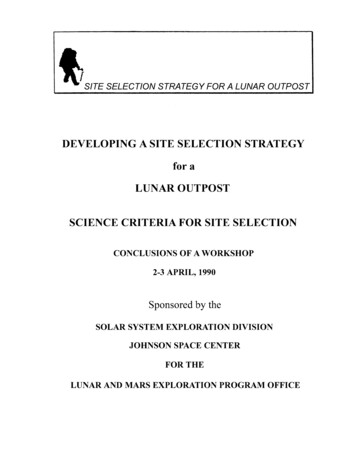
Transcription
bSITE SELECTION STRATEGY FOR A LUNAR OUTPOSTDEVELOPING A SITE SELECTION STRATEGYfor aLUNAR OUTPOSTSCIENCE CRITERIA FOR SITE SELECTIONCONCLUSIONS OF A WORKSHOP2-3 APRIL, 1990Sponsored by theSOLAR SYSTEM EXPLORATION DIVISIONJOHNSON SPACE CENTERFOR THELUNAR AND MARS EXPLORATION PROGRAM OFFICE
ForewordThe following report "Development of a Site Selection Strategy for aLunar Outpost Science Criteria" is one of two reports that explore the problem ofsite selection on the Moon from both science and operational perspectives for the Lunar andMars Exploration Office. The results reported here represent a cooperative effort betweenthe Lunar and Mars Exploration Office and the Office of Space Science and Applications.The science criteria discussed in the report are a distillation of the opinions and perspectivesof a part of the scientific community, and the general view of the discipline codes of theOffice of Space Science and Applications. Clearly, perspectives and priorities may changewith time, and this report is the beginning of a continuing dialogue that will take place asthe Space Exploratian Initiative Program moves towards establishing an outpost on theMoon-Michael B. Duke, Lunar and Mars Exploration Program Office
TABLE OF CONTENTSSUMMARY .Introduction, .,.IIS u m a r y of Science Criteria. . IIFundmental Criteria By Discipline. IIIAstronomy . IDSpace Physics. 1VLunar Geology. VGeophysics .Lunar Resources. . . .VVISummary of Site Information Needs. . VIEConcluding Statement.*.* . . J XREPORT OF THE LUNAR GEOLOGY WORKING GROUP .Introduction. . .a.O.,.1.,.Majar Problems Addressable from a Lunar Outpost.,.Develspnment rand Evolur-aonof the Cmst and Fkfantle.1.23Impact History. .4Nature of Impact Processes .4Regolith Formation and Evolution/History of the Sun .,.,. .4Eruptive Dynamics .5Enigmatic Features . 5Origin of the Moon. .5Ad& snal Features of Particular Interest . 5
Solving the Rob!ems: The Geological Appr ach.7Site Guidelines and Recommendations .8One Possible Approach to Geoscience from a Lunar Outpost:The Transect Method .u.Summary .9REPORT OF THE LUNAR GEOPHYSICS WORKING GROUP . 10Geophysics and the Lunar Outpost . 11Objectives .Global Geophysics .1111Regional and Traverse Geophysics . 11Criteria for Site Selection. 12.Global Geophysics .Seismology .1212Heat Flow . 12Magnetometry .12Atmospheric Measurements . 12Regional Geophysics .14Seismology . 14Traverse Geophysics . 14Mobility .14Global Network . 14Regional Network .REPORT OF THE LUNAR ASTRONOMY WORKING GROUP .1516Introduction .17Instrument Descriptions and Objectives.,. 17
Fundmend Site Selmtion a t e r i a for Near Side Observatories.Site M o m t i o n Requkmen@.Observatoq Ogerariond Considerations .SPACE PHYSICS WORKING GROUP.REBBRT OFIntroduction. .sa.a.a.Instrument &scription and Objectives .Fur damental Site Selection Criteria.Tahle 1REPORT OF Instrument Descriptions .G GROUP .LUNAR WSOURCES WO.Introduction .,.see.Sea.Fundamental Site Selection Criteria .a.s.*.Fundamental Criteria for Oxygen .Fundamental Criteria for Hydrogen (and Water) .Fundamental Criteria for Helium 3 and Other Light Gases.Fundamental a t e r i a for SimpleBuil&ng Matefids .Fu ldamentalCriteria based on Complex Materiais.Lunar Resource Criteria and Information Needs .Table 2 . Ranking of Site Preference for Products.WORKSHOP BA%PTICPANTS.
SITE SELECTION STRATEGYFOR A LUNAR OUTPOSTISCIENCE CRITERIAConclusions of a Workshop held April 2-3, 1990Johnson Space CenterIn 1990, the Lunar and Mars Exploration Office of the Office of Exploration began a series ofsteps to develop a strategy for selecting a site on the Moon for a lunar outpost. Although theestablishment of a outpost is not imminent, the problem is complex because of the impact that thesite that is selected will have on systems engineering, process planning, preparation of materials,simulator construction, and training etc. The range of choices should be narrowed significantlybefore missions to the Moon are flown to provide the global data base that will be essential in siteselection. Narrowing requires discussion and debate, consequently, it is not too early to begin toconsider what will be important in site selection for the Moon, including consideration of the datathat will be necessary to make sound judgements. Selection of a location for a Lunar Outpostshould be an orderly process of elimination of choices based on selection criteria that representscience, engineering, resources and mission safety, all developed within the context of the strategicpurpose of the outpost. The first step is to consider science criteria,A successful site selection strategy for the Moon based on science criteria has four attributes. Itshould be flexible (a flexible strategy requires an extensive data base) and multi-disciplinary, itshould be consistent with crew safety and utilization, and it should allow the fullest possible use ofhuman capabilities in lunar exploration.In cooperation with the discipline divisions of the Office of Space Science and Applications, aworkshop to develop multi-disciplinary science criteria was held in Houston at the Johnson SpaceCenter on April 2 and 3, 1990. The workshop was divided into discipline groups and each groupformulated criteria particular to their discipline requirements. The discipline groups, group leadersand discipline Code representatives were as follows:Group leader: F, Vilas, JSCCode SZ representatives: P, Swanson, B. Hines
ISITE SELECTION STRATEGYFOR A LUNAR OUTPOSTSPACE PHYSICSGroup leaders: A. Potter, T. Wilson, JSCCode SS representative: K.LangLUNAR GEOLOGYGroup leader: M. Cintala, JSCCode SE representative: T. MorganLUNAR GEOPHYSICSGroup leader: R. Phillips, SMU, LEXSWGChairmanLUNAR aESOlTRCESGroup leader: D.McKay, JSCIParticipants are listed in the appendix.Site selection criteria were formulated based on the assumption that there would be one outposton the Moon on the near-side,although there is no implication that the conduct of science would belimited to the outpost location. Latitude and longitude requirements (for observatories) and terraincriteria for lunar geosciences and resources are primary drivers. In addition, the physicalcharacteristics of potential outpost locations, topography, fsr example, were considered and havesome importance in site selection. The selection criteria developed for a single outpost location arethe following:1. h a t e astronomical instruments within 10 degrees of the lunar equator to maximize accessto the celestial sphere and ensure an adequate view of the Magellanic Clouds, and from 5 to10degrees of the mean lunar limb to maintain Earth always in the field of view, but low onthe horizon. Space physics observations of the Sun require the outpost to be located within2 degrees of the lunar equator.2. The outpost should be located at a carefully chosen mare-highland contact and on a maresurface for purposes of geological/geophysical exploration. Access to adjacent highlandsand to outcrop are requirements.3. A mature regolith is required for solar wind implanted resources (hydrogen and helium, forexample). Oxygen may be extracted from any material, but mare material may offer themost flexibility in resource design because undesirable components m y be extracted froma component-rich mare s i whereasldesirable components cannot be added to a
SITE SELECTION STRATEGYFOR A LUNAR OUTPOSTcomponent-poor highland regolith. The question (and criterion) however, remains openuntil an oxygen extraction process is selected.4. Some potential space physics experiments require a region low in KREEP to minimize theradiogenic component of the lunar regolith and the indigenous radiation,5. The outpost site should have a "flat" area for emplacement of instruments, e.g.observatories, A suitably located hill or large crater would offer substantial designadvantages for interferometers. In addition, the location selected should allow placement ofsome instruments at a distance of several kms or more from the outpost so as to minimizeinterferences in instrument operation.6. Some instruments (those that observe certain characteristics of the Earth) require being atthe subearth point. The requirements for these instruments are not compatible with thoserequireing, or preferring, limb sites. Instruments that require a far-side equatorial orantipodal subearth point were considered; however, their location is independent of a nearside outpost.FUNDAMENTAL CRITERIA BY DISCIPLINEASTRONOMY:Criteria were based on the requirements for the following instruments:Lunar transit telescopeOptical interferometer4 meter telescopeSubrnillimeter interferometerVery low frequency interferometerThe site selection criteria were based on field of view requirements (for the near and far side),topographic requirements for instrument placement, and communications and shieldingconsiderations. For observatories located on the near side, there are two fundamental locationcriteria:
SITE SELECTION STRATEGYFOR A LUNAR OUTPOST1. Observatories should be located within 5 to 10degrees of the mean lunar limb and within10 degrees of the equator.2. Observatories must be located so that observation of the Magellanic Clouds at an elevationof 15 degrees or more above the horizon is possible for a significant fraction of viewingtime.A near limb - equatorial location has the following advantages:Earth is always low on the horizon, minimizing light contamhation effects(81.4 degrees E and W are longitude limits at which the Earth is always inview)Line of sight to Earth maintained for communicationsVLF observation of Earth's auroral radiation is possibleSolar eclipse observation is possibleIn addition, there are site selectioncriteria for astronomy based on simplifying design throughjudicious use of topography:1. Select a flat plain or shallow bowl-shaped crater, thereby allowing maintenanceof line-ofsight between array elements, maximizing the fields of view, and utilize a hill or a largecrater for placement of beam combiners for interferometers to simplify design.2, Locate instruments far enough from the outpost to minimize interferences ande o r n r % a cfroma n the outpost, consequently requiring a larger area than would otherwisebe the case,SPACE PHYSICS:Criteria for space physics were based on requirements for the following instruments:* Sun ImagerEarth ImagerEarth SounderSolar ConstantSolar Magnetic FieldCriteria primarily based on field of view requirements are:
SITE SELECTION STRATEGYFOR A LUNAR OUTPOST1. Equatorial latitudes, or nearly so, are required for Sun observing instruments - the SolarConstant Observatory, the Sun Imager and the Solar Magnetic Field Observatory. The SunImager should be located within k 2 degrees of the equator.2 . The Earth Imager requires a location at the near side, close to the equator for observationsof the Earth.3, An anti-subearth point (180 longitude, Q latitude) location is preferred for observation ofthe magnetotail and magnetopause by the Earth Sounder, but a near side location would beacceptableTopographic and regolith chemistry criteria are:1. Select a flat plain with space to set up the 1.5 km focal length Sun Imager.2. Place experiments which measure radiation in a region of low background radiation, aregion low in K E E P (K, Rare Earth Elements, Phosphorus, U, 3%).LUNAR GEOLOGY:Criteria for geologic exploration of the Moon are functions of lunar exploration objectives andare not sensitive to longitude and latitude requirements, Because it is unlikely that a single site willsatisfy all exploration objectives, exploration of areas distant from the outpost will be required andsuch regions must be accessible, i.e., that the outpost cannot be isolated by virtue of topography.The fundamental criteria are based on an assessment of lunar exploration objectives and theimpetus to maximize the number of objectives attainable at a single site:1. Locate the outpost at a carefully chosen marehighland contact.2 . The mare-highland contact area selected must have an avenue for access to highlands frommaria or vice versa.This criterion implies that topographic-cartographic data must be available to determineaccessibility. Mare is defined as a flooded basin and highland is defined as an extensive region oflunar crust. In addition, the mare area should provide access to:* Sequences of flowsOutcrops
SITE SELECTION STRATEGYFOR A LUNAR OUTPOSTThe highlands should allow reasonable access to the following features:Plutonic rocksStructural featuresLight plains unitsFractured floor cratersGEOPHYSICS:Criteria were considered for lunar seismology, paleomagnetism and heat flow:1. Locate the site near or within a multi-ring basin for subsurface structural studies (possiblyalso near shallow moonquake centers) or locate the site in a homogeneous crustal region forseismic array studies of crust/mantle structure, or allow access to such a region. Theoutpost location must allow regional geophysical studies of these two fundamental lunarfeatures - mare and highlands, by humans. The outpost location should not exclude accessto one or the other. Similarly, the outpost must allow access to geologically diverseregions, including a multi-ring basin near shallow moonquake epicenters.2 . Locate the outpost near strong magnetic anomalies and/or intact mare basalt flows ofdiverse ages for paleomagnetic studies. Oriented samples of in-place rocks that cooled asliquids through the Curie point will provide critical data in paleomagnetic studies.3, Geophysical stations for heat flow should be ernplaced away from marehighland contactsfor improved heat flow data.Geophysical exploration of the deep interior of the Moon requires the emplacement of globalgeophysical stations. These stations have location criteria that are independent of the outpostlocation. For example, to look for seismic arrivals relevant to the existence of a central core, aglobal seismic array should be located to cover the antipodal region of known major deepmoonquake epicenters. (The epicenters are 16.6S, 39.8W and 4.6N, 116.5E).LUNAR RESOURCES:Criteria were based on the potential for utilizing lunar: 1) oxygen; 2 ) hydrogen, 3) helium 3 andother volatiles or light elements; 4) building materials requiring little processing (shielding material,bricks, ceramics, glasses) and 5) materials requiring extensive processing of lunar feedstock toproduce (metals, solar cells, cement, concrete)
SITE SELECTION STRATEGYFOR A LUNAR OUTPOSTCriteria for oxygen are dependent on the process that will ultimately be selected for oxygenextraction. Given present data, criteria may be developed to select the type of site that appears tooffer the best possibility of satisfying all feedstock compositional and physical propertiesrequirements:* Mare sites offer more chemical and mineralogical diversity.High Ti mare sites will make feasible a broader range of processing options.These criteria reflect a strategy that seeks to maintain flexibility in resource utilization, forexample, the location of the outpost should not be keyed to an oxygen extraction process. Asnoted, oxygen may be extracted from any lunar material. Mare regolith contains, on the average, amore complex mixture of mineral components than does a regolith derived from, say, ananorthositic substrate such as may exist at some places in the highlands. Consequently, marematerial may be a more flexible feedstock. Undesirable components may be removed from a mareregolith whereas desired components may not be added to a regolith. In this sense, mare surfacesappear to offer more flexibility, and within the mare suite of materials, ilmenite or titanium-richmaterials have the greatest potential for oxygen production, Regolith thickness is not a majorconsideration for oxygen production. Boulder-free terrain may make mining operations easier.Access to immature regolith is desirable for processes requiring mineral beneficiation.Hydrogen is a solar wind implanted component. All solar wind implanted resourcesincrease in abundance with exposure to the solar wind. Solar wind exposure is directlyproportional to regolith maturity as defined by a number of parameters including the effects ofmicrometeoritebombardment. Therefore, the criteria are:Regions with mature regolith preferred, Finer grain sizes have higher hydrogenconcentrations.Hydrogen content is directly proportional to ilmenite content, ilmenite (FeTi02) rich,mature regolith is superior. For soils of similar maturity, mare soils contain morehydrogen.Regolith thickness is important for hydrogen recovery. Thicker regoliths tend to be finergrained and more mature, Consequently they are likely to have a greater concentration ofhydrogen,3. Helium 3
SITE SELECTION STRATEGYFOR A LUNAR OUTPOSTSame as hydrogen.4. Building materials reauirinrr little processingMare materials superior (lower melting points).5. Materials requiring significant rocessingAll materials usableThe working groups determined that the following kinds of information are required or highlydesirable.1. Meter class altimetry data for site selection for observatory instruments, particularlyinterferometers, would greatly facilitate instrument siting.2. A thick regolith will be important for shielding, since a Coude' focus is possible if theregolith is thick enough. Regolith thickness can be estimated via crater morphologyobservations from high resoXution imagery.3 . Some potential experiments are sensitive to the radiation background, particularly gammarays, from the KREEP (K, REE, P and U, Th) component of the lunar regolith. Gammaray data for the lunar regolith will be important in detector design.4. Topographic data are essential for planning of geological and geophysical exploration. Theaccessibility of areas or features to be investigated from an outpost can be determined onlythrough analysis of topographic data.5. Chemical and mineralogical data and imagery provide a critical context for the planning ofgeological and geophysical exploration.6. Resource potential evaluation is dependent on the measurement of regolith composition,maturity and thickness, All three parameters are determinable or can be estimated fromlunar orbit with Lunar Observer instrumentation, Direct detection sf solar wind hydrogen
IXSITE SELECTION STRATEGYFOR A LUNAR OUTPOSTat 1 0 ppm levels is highly desirable. Regolith maturity mapping based on multispectraldata would be of great benefit in estimating resource potential.Definition of science criteria is one step on the road to developing a site selection strategyfor a Lunar Outpost. The criteria so far defined are not mutually compatible in all instances and theresolution of conflict will be the subject of future programmatic and scientific debate to determinewhere compromise is required or is possible. Continuing dialogue is the key to developing astrategy that is satisfactory on a multidisciplinary scale. As is pointed out in the section ongeological criteria, an increase in the knowledge base may have a profound impact on explorationstrategy and result in a different weighting of the criteria. Judgements made from an adequate database of global propgtions are more likely to result in the achievement of objectives.Science criteria are not the only parameters that will dictate outpost location. Operationalconsiderations have an impact on how well science operations can proceed at a locality and maydetermine whether or not particular scientific objectives can be achieved at a given locality.Mobility strategies that may be employed are crucial as well. These considerations and therelationship between multidisciplinary science criteria were explored at a follow-on workshop heldin August of 1990 at the Johnson space Center under the auspices of the Lunar and MarsExploration Program Qffice. As that workshop, the process of selecting a site was simulated byconsidering the merits of six locations on the Moon that were selected to serve as examples oflocations with a wide range of characteristics. Results are reported by the Lunar and MarsExploration Office in ,4 S'te1 Selection Stratew for a L u n a r *
Reportof theLunar Geology Working GroupLunar Butpest Site Selection Strategy Workshop2-3 April, 11990Mark CintdaPaul SpudisGraham RyderJames J. PapikeDonald BogardB. Ray HawkeParssf D,%,owman,JrJeffrey B. PlesciaDonald S. Burnett
LUNAR GEOLQGY AND A LUNAR OUTPOSTThe existence of a lunar outpost will revolutionize our knowledge about the Moon and, byextension, planets in general. Geological field work during ApoHo was limited to relatively smallareas around the landing sites, and each task to be accomplished by the EVA crew was part of astrict timeline imposed by engineering and life-support considerations. As a result, the geologicaltraverses performed on each mission were planned in minute detail long before launch, and -perhaps most importantly -- with little information available regarding the area to be explored.When plans were applied to reality, it was found to no one's surprise that flexibility was stifled bythe constraints: unexpected discoveries or difficulties more often than not required deletion ofplanned objectives in order to accommodate the time demanded by the unforeseen circumstance.True geological field work, which is a highly iterative process that often takes years to complete,has been performed only on the Earth. This problem will be remedied -- at least conceptually -upon beginning the first field trip mounted from the lunar outpost. That excursion will be to alocation in the immediate vicinity of the outpost itself, and thus will be visited easily on anynumber of subsequent occasions, if deemed necessary. The extent to which the importantproblems in lunar geoscience can be attacked by these field activities will depend upon the time,flexibility, and, perhaps most importantly, mobility afforded by the lunar outpost,Time is required for the successful execution of field work because of thecomplexities of geologic processes themselves as well as the interactions betweenthem. In addition to sampling activities, a geologist must study the physicalproperties and examine the overall context of a unit ilz thefield. More often thannot, this is a formidable undertaking on the Earth; on the Moon, where billions ofyears of impacts have done an admirably thorough job of randomizing thegeological record, the task is even more daunting. The complexity of a problem, ingeneral, determines the time required for its solution; on the Moon, few problemswill be simple to solve.Taken as a whole, a planet possesses almost biological intricacy: the huge numberof variables affecting geological processes and their inten elationshipsmakes thosemechanisms highly resistant to the "cookbook'bpplication of physical or chemicalequations. Because of these complexities, a geologist makes new discoveries ofvarying significance each time he or she ventures into the field; these discoveriescombine with existing knowledge to determine the next step in the investigation.The result is a kind of "free-form" approach to problem solving -- one that requiresa high degree offlexibility to impleinent. If one knew exactly what to expect at agiven field site, there probably would be no scientific reason to go there, becausethe problem very likely would have been solved. Since the converse is much moreoften the case, the means must be made available to accommodate newly acquiredinformation and to reformulate plans accordingly,Just as a physician cannot make a precise diagnosis on the basis of a singleobservation, neither can the geologist confidently extrapolate observations made at asingle location ts a process affecting thousands of cubic kilometers. A singleprocess can assume many guises, and radically &fferent mechanisms often possess
nex1.j ir,distinguishab!e manifestations. To compound the difficulties, the mostimportant questions in lunar geoscience are, more often than not, planetary in scale.These realities necessitate significant mobility across the lunar surface. Mobility is,if such a prioritization could be made, perhaps the most important of the threerequirements. The need for time in the geological exploration of the Moon shouldbe met eventually as the lunar outpost consolidates and matures; once the timebecomes available, it will be used to increase flexibility in the field. Neither,however, will be exploitable to its fullest extent without the ability of the explorersto go to the important localities.This report of the Lunar Geology Subgroup's activities during the Site Selection StrategyWorkshop assumes -- explicitly at some times, implicitly in others -- that time, flexibility, andsignificant mobility will be available to the people who will perform the field work. Should any ofthese three parameters be eliminated or eroded, the rationale, recommendations, and objectivespresented in this report will require a fundamental reassessment.Finally, it must be pointed out that the deliberations of the Subgroup were conducted with theprospect of Lunar Qbserver very much in the fore. If necessary, an outpost site could be selectedfor geoscientific purposes almost immediately. To do so in the face of such an exciting mission asLunar Observer, however, would do a great disservice to lunar science in that the site would not beoptimized on the basis of all data available before the construction of the outpost. Only a smallfraction of the Moon's surface has been photographed at high resolution, and an even smallerfraction has been mapped geochernically. The explicit objective of Lunar Observer is to provideglobal coverage of the lunar surface with an m a y of instruments, among which are imagingsystems and geochemical mappers. It should, therefore, be expected that once Lunar Observerdata become available, new items will be added to the list sf features to study and sites to beinvestigated .Major Problems Addressable from a Lunar OutpostIn order to construct a framework within which the discussion would take place, the Subgroupdecided to list the principal t
The following report "Development of a Site Selection Strategy for a Lunar Outpost -Science Criteria" is one of two reports that explore the problem of site selection on the Moon from both science and operational perspectives for the Lunar and Mars Exploration Office. The results reported here represent a cooperative effort between
